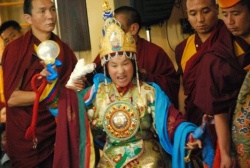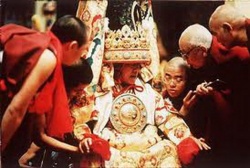History of Nechung
Nechung monastery in Tibet lies just below Drepung monastery, four miles west of Lhasa, the country's capital. Nechung originally came to Tibet with a descendant of the Indian sage Dharmapala.
During the reign of King Tri-Song Deu-Tsan in the eighth century AD, he was appointed protector of Samye Monastery by the Indian saint and tantric master Padmasambhava.
At that time, Samye, Tibet's first monastic institute, was known as Nechen (the larger site) and Nechung (the smaller site).
Although there are different versions about the origin of Nechung monastery in Tibet, learned monks at the re-established monastery in exile in Dharamsala, maintain that once when the great translator Vairochana visited the smaller site, he envisioned a miracle connected to the Drowa tree and reported the incident to Guru Padmasambhava.
He prophesied: "A monastery will be built on that site and, the nearby small lake and the tree are possessed by Pehar's spirit."
(Pehar Gyalpo was bound to oath by Padmasambhava to head the entire hierarchy of protective spirits and Dorje Drakden, Nechung, was Pehar's principal emissary to Tibet).
With the aid of protective spirits, the task of spreading religion in Tibet was accelerated.
Later, Mune Tsan-Po, son of King Tri-Song Deu-Tsan, built a small monastery and established a Sangha community.
Ba Pel-Yang became it's first abbot and an image of goddess Tara was brought to the monastery from Samye.
Consequently, this monastery came to be known as [[Nechun] Yulo-ko]] and generations later, the tiny village of the seat of Nechung adopted the name of the monastery and was called Yulo-ko.
The village still exists today and is known by the same name.
Another version says that there was a monastery known as Tsal Gang-Thang on the other side of Kyichu river, east of Lhasa, where Shang Tsal-Pa Tsondu Dakpa, a disciple of Lama Ongom Tsultrim Nyingpo lived.
Originally, Pehar was the Dharma Protector of this monastery. However, Lama Shang, in feud with Pehar, decided to abandon the spirit in Kyichu river performing an appeasement-rite and packed all his belongings in a box.
Chog-Pa Jangchup Palden, a resident caretaker of the chapel on the site, where later Drepung monastery was to be established, happened to know through his clairvoyance that Lama Shang was in the process of abandoning Pehar in Kyichu river.
He, therefore, advised his attendant to seize the box and bring it to him without opening it.
The next morning, when the attendant went to the river bank, he was astonished to find the box float toward him.
He then carried the box on his back and set forth, until he sensed that it had become much heavier when he reached the place where Nechung was later to be established.
He, therefore, took a rest. But wondering what could be in the box, he started to sneak stealthily through it, when suddenly a pigeon flew out of the box and disappeared into the Drowa tree.
Startled as he was, he suddenly recollected his master's instruction which he had transgressed, and exclaimed: "May the Lama know!" These words, later inscribed on the same rock where he unloaded the box, can be seen even today.
The attendant, however, proceeded regretfully to his master and reported the incident.
His Lama, Chok-Pa Jangchup Palden, responded:
"It shows that the location is too small to house this powerful spirit."
It was here on the same location where Chok-Pa Jangchup Palden built a small monastery and organised a Sangha community.
This is how Nechung Monastery came into being about eight hundred years ago.
The principal architect of Nechung Dorje Drayang Ling was the Great Fifth Dalai Lama, Ngawang Gyatso (1617-1682). it was on his advise and guidance that the monastery was expanded during the regency of Desi Sangye Gyatso in honour of the Oracle in 1681 and completed in 1683.
The second Dalai Lama, Gedun Gyatso (1475-1542), had developed a close relationship with Nechung.
When the Great Fifth Dalai Lama gained temporal Power in 1642, he instituted Pehar Gyalpo as the Protector of the Tibetan government.
To house this spirit, Nechung monastery was constructed around the original shrine.
Thereafter, a number of the sacred vessels, through which Pehar Gyalpo could be contacted, were moved from Samye and the monastery was instituted as the official home of the state oracle of Tibet.
Since then, it became the responsibility of the Tibetan government to oversee the development of Nechung monastery. It not only supported the monastery, but enlarged its maximum strength to 101 Sangha members.
The government, however, held Nechung monastery responsible for keeping intact daily link with Tibet's main spirit Protector, Pehar Gyalpo.
Many traditions of rituals and practices, such as the Treasure Doctrine of Nyang Nyima Odzer, were practiced and preserved by the monastery.
The Great Fifth Dalai Lama compiled a collection of liturgy text known as Dra Yang-Ma and incorporated this as one of the principal practices of Nechung monastery.
Thereafter, the monastery was named Nechung Dorje Drayang Ling (The Immutable Island of Melodious Sound), by the regent, Desi Sangye Gyatso.
During the time of the Great Thirteenth Dalai Lama, Thupten Gyatso (1876-1933), with the admission of 14 additional monks by him, the number of monks in Nechung monastery was increased from 101 to 115. Since then, this was the standard strength of the monks residing in Nechung monastery.
However, following the 1949 Chinese invasion of Tibet, Nechung monastery, like the rest of other religious institutions in the country was completely destroyed.
The Vajra Acharya Venerable Thupten Phuntsok of Nechung monastery in exile in Dharamsala, told the Tibetan Bulletin that according to their Information, the partially-reconstructed monastery in Tibet now has about 16 monks.
Most of the senior monks have died. The new monks have been able to memorise the texts of the rituals and are reportedly perfect in terms of their spirit, but have little opportunity to learn, study and receive teachings.
"So their training remains incomplete and hence, a drawback. Our monks in Tibet have suffered tremendously under the Chinese rule.
They still have difficulties because their freedom is limited and their future very insecure," says Venerable Thubten Phuntsok, who joined Nechung monastery in 1930 and until his escape from Tibet in 1959 had served under three Nechung Kuten.
It also has been reliably learned that at present the Chinese authorities in Tibet have especially laid strict vigilance to obstruct the re-establishment and growth of Nechung monastery in occupied-Tibet.

